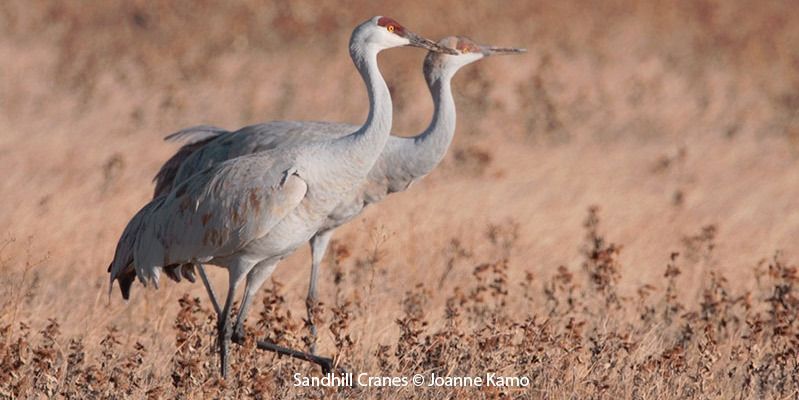Whooping Cranes
Major Victory for The Aransas Project
From The Aransas Project Press Release
On March 10, 2013 The Aransas Project (TAP) applauded a major federal court decision in its legal battle to protect the last naturally migrating flock of endangered whooping cranes as a vindication of the need for an effective water management plan, especially during times of drought, for the Guadalupe and San Antonio River basins.
On March 10, 2010, TAP filed a lawsuit against several officials of the Texas Commission on Environmental Quality (TCEQ) in their official capacities for illegal harm and harassment of Whooping Cranes at and adjacent to Aransas National Wildlife Refuge in violation of the Endangered Species Act. The case went to trial before the United States District Court for the Southern District of Texas in December 2011. Today’s historic decision by United States District Judge Janis Graham Jack comes three years to the day after the original filing.
“We are both humbled and pleased by the Court’s historic decision,” said TAP’s Lead Counsel Jim Blackburn. “For this important river and for the Whooping Cranes, the Court’s opinion provides a clear statement of the need for an effective management plan for this river basin during times of drought to ensure adequate freshwater flows reach the bay. The decision is also a vindication of the sound science and the dedicated efforts of the longtime Whooping Crane Recovery Coordinator, Mr. Tom Stehn, to preserve these magnificent birds.”
The Case for Whooping Cranes
by Mary Carter
With special thanks to Jim Blackburn, attached is a reprint of part of Jim’s Coastal Update for 2011. This section describes the Whooping Crane litigation which took place in December in Corpus Christi.
The trial was the experience and event of a lifetime. I felt like I had been learning and practicing for thirty years for this case. I represent The Aransas Project (TAP), a non-profit group formed to protect San Antonio and Aransas Bays in an attempt to secure freshwater inflows for this important estuary. TAP filed suit against the Commissioners and the Executive Director of the Texas Commission on Environmental Quality (TCEQ) and the South Texas Watermaster for violating the federal Endangered Species Act. We alleged that the TCEQ allowed so much water to be removed from the San Antonio and Guadalupe Rivers that the bay salinity was changed beyond what the drought would cause, leading to less food supply for the Whooping Cranes, altering the drinking water supply of the Whooping Cranes and ultimately causing the death of 23 cranes during the winter of 2008–2009.
The trial lasted for about two weeks. It was a bench trial, meaning that there was no jury. Instead, the case was heard by Judge Janis Jack in her Corpus Christi federal courtroom. TAP put on 10 expert witnesses, five citizen witnesses and called two TCEQ employees as adverse witnesses. The TCEQ defendants were joined by interveners Guadalupe Blanco River Authority (GBRA), San Antonio River Authority (SARA), and Texas Chemical Council (TCC), with GBRA assuming a major role in the defense effort. Together the defendants called 11 expert witnesses. At the end of the trial, Judge Jack indicated that she wanted us to file written closing arguments and indicated that she may not issue a ruling before the end of summer.
The case was complex. We put on two types of evidence that linked Whooping Crane deaths to freshwater inflows. We put on statistical evidence linking freshwater inflows to whooper mortality, and we then put on a step-by-step chain of causation evidence that linked Whooping Crane mortality to poor food supply and needing to fly inland for fresh drinking water, rather than drinking brackish marsh water.
I feel very good about our case and our evidence. I think our witnesses were excellent across the board. These experts were willing to put themselves on the line for the bay and for the whoopers. I and all crane supporters are indebted to them all. We also had a number of citizen witnesses who testified as to their concern for the bay and the birds and the uses that they made of the bay. And let me add that I have never had a more diverse or impassioned group of coastal advocates than the members of TAP. TAP has over 30 environmental groups and businesses as members, including national, statewide and local environmental NGOs (including Houston Audubon), as well as Aransas County and the City of Rockport and both the Republican and Democratic Clubs of Aransas County. I’m really proud of that across-the-political-spectrum support. Our legal team was assembled from both our office and partially-paid volunteer lawyers who made great contributions. I am grateful to them all for their knowledge, expertise, and help.
There are times when, as a lawyer, I have questioned the justice system. This experience renewed my faith. I don’t know if we will win or lose. I do know that we got a fair hearing. The issues before the judge are extremely difficult. The stakes are high, especially as we find ourselves today in the midst of another severe drought. But I rest much easier at night knowing that I did my best to try and protect something truly important. There is no price on the Whooping Crane. There is no price on being able to take a young boy or girl to the bay and catch a fish or see a shrimp jump out of the water or catch a crab or see a beautiful pink bird gliding across a coastal flat in the early morning sun. Some things are simply priceless.
Resources
-
Ruling on Water Policy Could Be Felt Across the State.
-
Texas Challenges Permit Ban Protecting Endangered Cranes.
-
Environmentalists handed victory in whooping crane water case.


